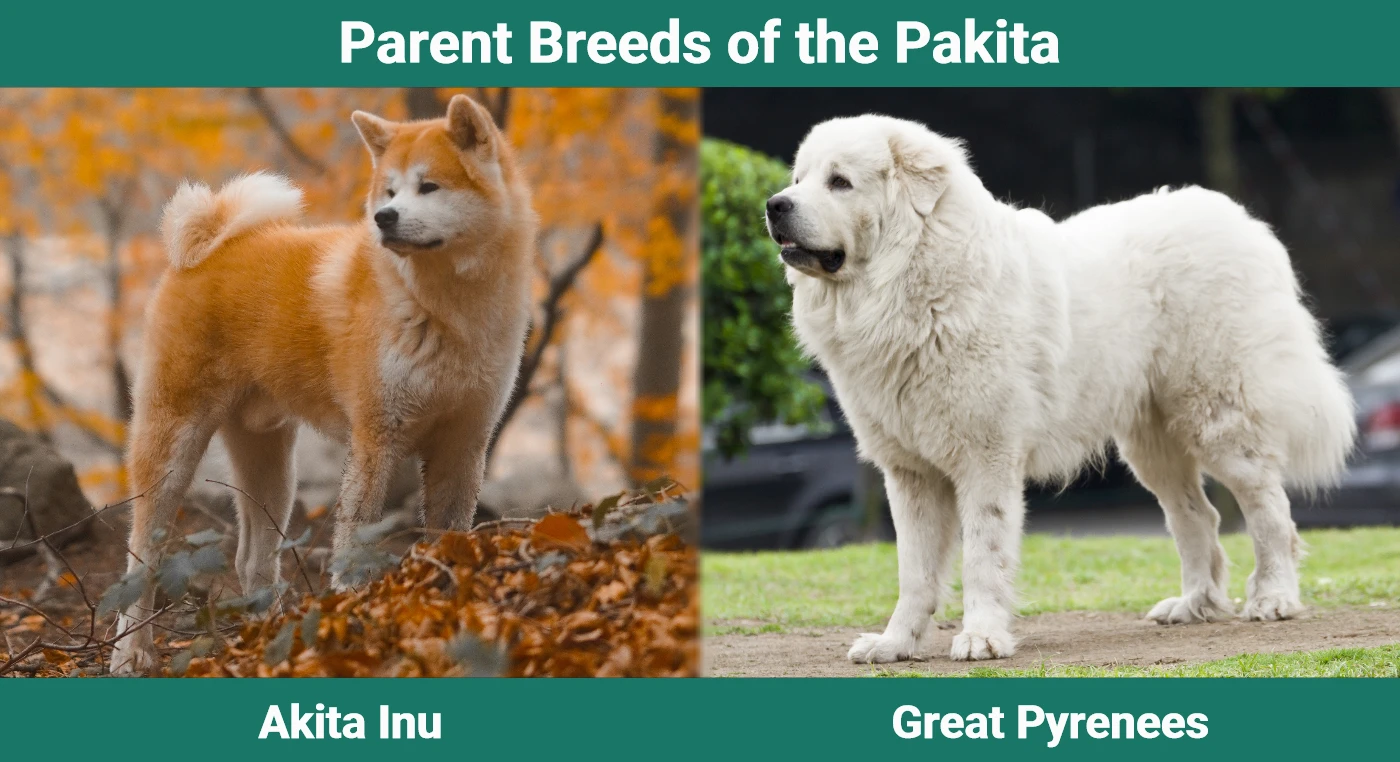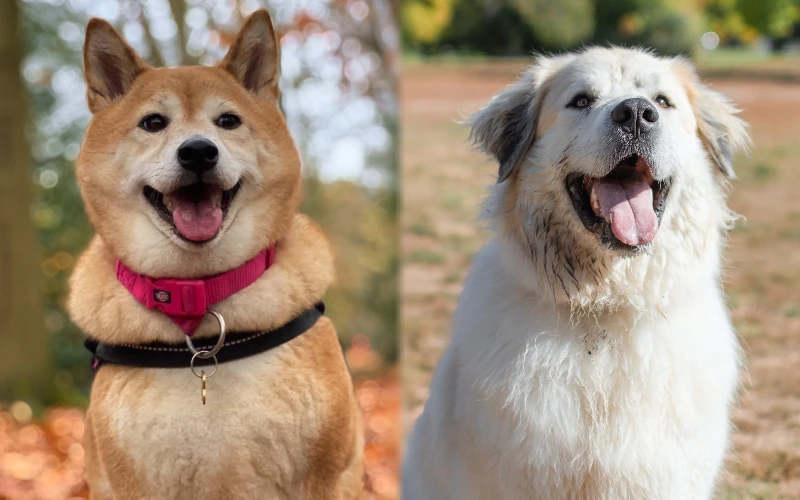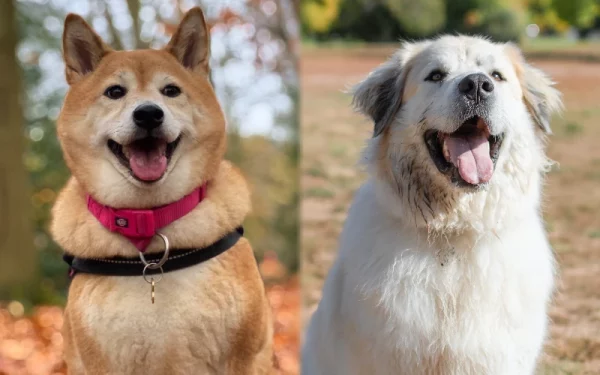Click Below to Skip Ahead
Few dogs are as recognizable as the Akita or Great Pyrenees. Both breeds have extremely unique appearances and large fan followings. So, what happens when you combine them? You can get a Pakita, a rare and unique mixed-breed dog that could be a treasure waiting to be found!
Breed Overview
Height:
28–30 inches
Weight:
100–120 pounds
Lifespan:
11–13 years
Colors:
White, black and white, silver and white
Suitable for:
Outdoorsy families, people with land or animals, people looking for a good guard dog
Temperament:
Loyal, alert, protective, and intelligent
One purebred Akita is bred with one purebred Great Pyrenees to create a new breed, the Akita Great Pyrenees Mix. Both parent breeds have long histories that stretch back into the ancient past and large groups of people who are die-hard fans of each. Together, they create the Pakita, a mixed breed that is fuzzy and loyal and thrives in outdoor and cold environments.
Pakita Puppies
Akita Great Pyrenees Mixes are not super common. Finding a breeder who is willing to help you get one is going to be a challenge. Mixed breeders are not as common as purebred breeders, so you might have to try to pull two breeders together who are willing to mix and match their stock of Great Pyrenees and Akitas for you. The other way to potentially find a Pakita puppy is by stumbling upon one in a shelter or with a rescue group, but again, this would be uncommon.

Temperament & Intelligence of the Pakita
The Akita Great Pyrenees Mix is loyal, stoic, intelligent, protective, stubborn, and relaxed. These dogs can be the largest couch potatoes on the planet or agitated guard dogs. They were bred to wander around large open areas and like to have things to see and sniff and areas to walk around and explore. These dogs can be amazing for single individual owners whom they bond with. They are trainable, but the training process can be difficult, especially for inexperienced dog owners.
Are These Dogs Good for Families? 🏡
Sometimes. Pakitas will not be a good fit for every family. Families with small children (ages 4 and under) should be particularly careful when adopting a Pakita. Small children are the most likely people to accidentally get bit by a dog, and these dogs are so large and potentially skittish that they can pose a serious bite risk to small children. Active families with older children should have few issues with a Pakita. Make sure to try out any new dog, especially a large dog like a Pakita, before bringing them home to your family permanently.
Does This Breed Get Along With Other Pets? 🐶 😽
Sometimes. These dogs are large and have protective tendencies. Akitas were used to hunt small game (squirrels, cats, rats, etc.) in Japan, so they still have some of this drive that can make them dangerous to small pets. Great Pyrenees dogs are often chill, but they are livestock protection dogs, and they also have a trigger in their brain that will make them act aggressively toward other animals that they feel are a threat.
If introduced properly, Pakitas should be fine with most other dogs and small pets. However, there could still be problems. Some Pakitas might act aggressively toward small animals, so caution is urged if you are going to bring them into a house with existing pets.
Things to Know When Owning a Pakita
Here are the key things that you need to know about owning a Pakita, including their food requirements, exercise needs, grooming needs, and potential health conditions to be aware of. You should be familiar with the basics of each major category before attempting to adopt a Pakita of your own.
Food & Diet Requirements 🦴
The Akita Great Pyrenees Mix is a large dog, and that means they are going to require a sizable amount of food to keep them healthy. You will need to budget a good amount per month to keep your Pakita properly fed. They’ll likely need 3 to 4 cups of food per day, especially if they are young and if you keep them active.
It is recommended that you get a well-formulated dry food that focuses on either joint health (for active dogs) or skin health, depending on their allergies. With their long double coats, these dogs can get skin irritation and shedding problems that can be helped with special foods that target their skin and coat.
Exercise 🐕
The Akita Great Pyrenees Mix enjoys spending time outside. They will benefit greatly from long walks. They don’t necessarily need to have intense play sessions or high-intensity exercise to get out their energy. These dogs will enjoy walks, jogging, or hiking. They will also enjoy having a large yard or piece of land to wander on, as that is how their parent breeds lived in the past. You will need to set time out of your day to take your Pakita for a long walk, but you don’t need to take them to the dog park or doggy daycare to get extra playtime.
https://www.instagram.com/p/CH1LkVLhsnC/?utm_source=ig_web_copy_link
Training 🦮
Akita Great Pyrenees Mixes will require a good amount of training. Due to their size and their attentive nature, Pakitas need to be on voice control around strangers and when they are out in public. These dogs are loyal and should be eager to please their owner. However, they can also be stubborn, and when they don’t want to do something, they will likely flat-out refuse. Since these dogs can be up to 120 pounds in size and potentially aggressive, training and socialization are imperative.
Grooming ✂️
Pakitas will require a moderate amount of brushing and a minimal amount of grooming. Both Akitas and Great Pyrenees have thick coats. However, both breeds also have so-called “natural” coats that require little input from humans. An Akita will keep themselves clean and groomed on their own, kind of like a cat. Pakitas will need regular brushing to help remove dead hair and skin. Otherwise, these dogs will need standard baths when they get smelly or dirty. They do not need any special considerations beyond that.
Health and Conditions ❤️
The Akita Great Pyrenees Mix is generally a healthy dog. This is doubly true if you use healthy parent purebreds that are sourced from ethical and effective breeders. Good breeders can screen out most of the lingering issues common to Akitas and Great Pyrenees. A healthy Pakita can live to be 13 years old.
The most serious health concern for the Akita Great Pyrenees Mix is bloat, a serious condition in which the stomach inflates and twists on itself. It can be fatal if not treated immediately. Any dog that shows signs of bloat needs to be taken to the veterinarian right away, as it’s considered a medical emergency that needs treatment to avoid death. Every Akita, Great Pyrenees, and Pakita owner needs to know the signs of bloat and act accordingly if spotted.
- Allergies
- Vision issues
- Bloat
- Thyroid disorder
- Hip or elbow dysplasia
Male vs. Female
In both Akitas and Great Pyrenees, the female is noticeably smaller than the male. That means that a female Pakita will be smaller than her male counterpart. In both parent breeds, the female can be 15 to 30 pounds lighter than the male and 2 to 4 inches shorter. That means that a female Pakita will likely be 20 pounds lighter and 3 inches shorter than a male.
3 Little-Known Facts About the Pakita
1. The Akita Great Pyrenees Mix Possesses an Ancient Pedigree
Both the Akita and Great Pyrenees have ancient lineages that stretch back for thousands of years. The Akita has been a mainstay in Japan almost since records were kept in that ancient land. Great Pyrenees dogs are so old that there have been fossils of them recovered that date back 3,000 to 3,800 years. That means the Pakita is a unique combination of two of the oldest dog breeds in existence.
2. They Make Excellent Guard Dogs
Both the Akitas and Great Pyrenees dogs are alert and loyal. That makes the Pakita an excellent guard dog. If you are looking for a dog that will alert you when strangers are nearby or will make you feel safe when you are out on a walk or jog, the Pakita will do a fabulous job. Just make sure that you have your dog well-trained to avoid any potential mishaps with unfamiliar people.
3. Pakitas Can Excel in Cold Weather and Climates
Both the Akita and the Great Pyrenees have coats that can withstand cool and cold weather. Akitas love it when the weather starts to turn cooler, and they seem to power up when the thermometer drops. Similarly, Great Pyrenees dogs have thick double coats suited for snowy mountain hillsides. Both breeds evolved and adapted to mountainous terrain. Together, the combination creates a mixed dog that will absolutely excel in cold climates and northern areas.
Conclusion
The Pakita is a large dog with many upsides. They are cute, fuzzy, loyal, and protective. However, due to their immense size and protective nature, they need to be socialized and trained so they do not become a bite risk. These pups would do best with experienced owners who know how to manage a large dog around other canines and animals, children, and strangers. If you have a firm hand or the right property, these dogs can be lovable and loyal companions for many years to come.
See also:
Featured Image Credit: Left – Charlotte Rush, Unsplash | Right – Ryan Leeper, Pexels











